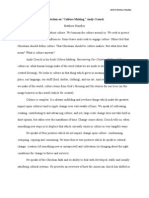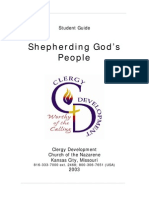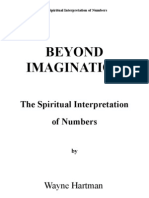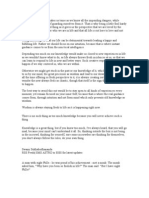Book Reflection On "Preaching To A Post Everything World" by Zack Eswine
Book Reflection On "Preaching To A Post Everything World" by Zack Eswine
Uploaded by
Matthew HundleyCopyright:
Available Formats
Book Reflection On "Preaching To A Post Everything World" by Zack Eswine
Book Reflection On "Preaching To A Post Everything World" by Zack Eswine
Uploaded by
Matthew HundleyOriginal Title
Copyright
Available Formats
Share this document
Did you find this document useful?
Is this content inappropriate?
Copyright:
Available Formats
Book Reflection On "Preaching To A Post Everything World" by Zack Eswine
Book Reflection On "Preaching To A Post Everything World" by Zack Eswine
Uploaded by
Matthew HundleyCopyright:
Available Formats
NotesonZackEswinesPreachingtoaPostEverythingWorld
AssembledbyMatthewHundley
Reflection on Preaching to a Post-Everything World: Crafting Biblical Sermons That Connect with Our Culture, Zack Eswine Assembled by Matthew Hundley In Preaching to a Post-Everything World, Zack Eswine offers up a kitchen sink full of formulas for crafting Christ-centered sermons. Rather than weave through the knowledge bites, I will present some of the key preparation tools (pulled out of the sink) for the sake of reference: Four Cs for Preaching 1. Content: facts about God, people, place and self 2. Character: preachers must explain relationships presented in scripture 3. Conscience: sound exposition and discerning contextualization are necessary, but insufficient 4. Culture: expose assumptions; discern biblical mandate from cultural suggestion Reality 1. Things that actually exist, that are authentic, that align with what is there 2. Some things are real in ways that differ from other things 3. Reality not only differs in kind, but also in capacity 4. Creation mandate and wisdom are Gods call into reality 5. Biblical wisdom teachings people how to navigate reality Context of Reality (definition) The mutual life environment that contemporary believers/unbelievers share in common with those to/about whom the biblical text was written, that teaches us about the nature of reality.
NotesonZackEswinesPreachingtoaPostEverythingWorld
AssembledbyMatthewHundley
When presenting reality, never fall into the trap of using 1. Expository Bans: avoiding aspects of reality; refusing to mention from pulpit 2. Expository Censoring: passing over or dumbing down difficult passages 3. Expository Muting: avoiding risqu or bigoted passages 4. Expository Equivocations making a far-reaching link in order to make a passage relevant 5. Expository Evictions overlooking cultural setting of text 6. Expository Cynicism unwitting ban of authentic goodness Pastoral sensitivity 1. Prepare people for painful topics. 2. Spare people the gore. 3. Dont spare people the glory. 4. Be aware of people. 5. Share multiple opportunities with people. 6. Lear care from scripture.
FCF = Fallen Condition Focus (Bryan Chapell) The mutual human condition that contemporary believers share with those to or about whom the text was written that requires the grace of the passage for Gods people to glorify and enjoy him (or for those who resist God to properly regard him and be reconciled to him).
NotesonZackEswinesPreachingtoaPostEverythingWorld
AssembledbyMatthewHundley
Four Fs 1. Fallen inner tendency toward temptation (spiritual hardness; warring desires; flesh) 2. Finite must live within the limits of knowledge and understanding 3. Fragile feeling effects of sin by circumstance (mental and physical limitations) 4. Faltering what we profess versus what actually is truth (the gap)
Echoes of Redemption 1. Divine Armor (truth, righteousness, peace, faith, salvation) 2. Divine Beatitude (promise, provision, grace) 3. Divine Wisdom (fruit: love, joy, patience, kindness, etc) 4. Divine Gifts (of the spirit) 5. Divine Diaconate (mercy) 6. Divine Miracle (sign of context for instruction) 7. Provision of Community (comfort in company) 8. Divine Silence 9. Divine Self
NotesonZackEswinesPreachingtoaPostEverythingWorld
AssembledbyMatthewHundley
Expository Eclipse 1. Eclipse Christ give priority to Christ as our example versus Christ as provision 2. Eclipse Fallen Biblical Characters not just to observe fallen behaviors, but ask now what? 3. Eclipse Judgment dont whitewash or sugarcoat the judgment and discipline of God 4. Eclipse Wisdom applying our wisdom versus that of the original author Sermon Structure 1. Surface Theme foreshadows the big idea 2. Echo of Creation highlight mutual human nobility 3. FCF highlight mutual human crippling 4. COR highlight the mutual life environment 5. Bond to the Text identify big idea (main theme of biblical text; resonance) 6. Big Idea clearly state main thing that the text says 3 Strategies Surrounding The Big Idea 1. Parrot Words - use words, phrases or concepts that alert the listener to passages of primary importance 2. Divine Comments statement in the narrative that highlights the governing theme of the passage; usually the moment where everything changes (after the climax) 3. Plain Statements clear pronouncement of what we are supposed to gain by the passage
NotesonZackEswinesPreachingtoaPostEverythingWorld
AssembledbyMatthewHundley
Taking Things Scene-by-Scene 1. Identify Scenes 2. Create Headlines 3. Cross Examine (use guiding questions) 4. Tell the Story a. Highlight key words. b. Help audience walk in their shoes. c. Connect stories d. Highlight surprises e. Use imagine maybe I dont know X, but I do know Y Deductive Approach 1. Locate Big Idea 2. Interrogate the Idea (who, what, where, when, why, how) 3. Show & Tell Recognize, Analyze, Organize 1. Show our answers 2. Recognize dissonance 3. Analyze our answers
NotesonZackEswinesPreachingtoaPostEverythingWorld
AssembledbyMatthewHundley
Apply Narrative 1. Intention 2. Human Condition 3. Human Situation 4. Divine Provision 5. Like Conditions, Situations and Provisions 6. Near Application (Apply to Our World) Sermon Implications (Related to Audience) 1. Dont assume people are familiar with the Bible. a. Help them get to the passage. 2. Speak as if non-Christians are present. 3. Do not ridicule, mock weaknesses of people. 4. Present yourself as credible (be transparent). Redemptive Vulnerability 1. Even great men struggle (With faith, with sin) 2. Great knowledge often comes about in our moments of weakness. 3. Jesus shed tears, expressed joy, was angry, felt sadness/sorrow, felt distress. 4. Pauls teaching was interspersed with testimony.
NotesonZackEswinesPreachingtoaPostEverythingWorld
AssembledbyMatthewHundley
Four Kinds of Criticism 1. Style/Handling youre not like my favorite preacher 2. Competence/Clarity you could have done better 3. Character your motives are wrong 4. Calling you shouldnt preach Guide to Testifying 1. God is the Hero 2. Show Redemptive Vulnerability 3. Vary Testimony 4. Speak with Sensitity 5. Anchor Your Story with Scripture 6. Turn The Mirror Use Visual Aids To 1. Draw Attention 2. Present Central Thoughts 3. Employ the Eye, as well as the Ear 4. Aid Memory 5. Greater Influence Listener
NotesonZackEswinesPreachingtoaPostEverythingWorld
AssembledbyMatthewHundley
God = King of Preachers 1. God enables preachers to encounter cultural realities previously unknown. 2. God calls preachers as instruments by which he speaks to neighborhoods and nations. 3. God is omnilingual and omnipresent. 4. God is able to offer refuge and present help for the trouble of any locality, anywhere, anytime. 5. Bible can be seen as a collection of Gods sermons. 6. Biblical preaching is about presenting the truth in the way the biblical writers/speakers would have presented it. Four Preaching Essentials (According to Paul) 1. Must be Christ-centered: Christ central to content, purpose and power of preaching. 2. Must be prophetic: give warning. 3. Must be catechtical: priestly: teach everyone. 4. Must draw upon wisdom: reality, perception, behavior Four Story Questions 1. What does the text teach us about God? 2. What does the text teach us about People? (religious/irreligious) 3. What does the text teach us about Place? (creation/cultures) 4. What does text expose about our personal response? (conscience)
You might also like
- Book Reflection On Peter Scazzero's "Emotionally Healthy Spirituality"Document2 pagesBook Reflection On Peter Scazzero's "Emotionally Healthy Spirituality"Matthew Hundley100% (1)
- Barrett The MagusDocument286 pagesBarrett The MagusAbdulkarim Darwish97% (29)
- Thinking Theologically - Adventist Christianity and The InterpretaDocument7 pagesThinking Theologically - Adventist Christianity and The InterpretaK. Banteilang NonglangNo ratings yet
- To Be Like Jesus: An Appraisal of Biblical Theology in Practice of Personal and Ministerial Spiritual Formation.From EverandTo Be Like Jesus: An Appraisal of Biblical Theology in Practice of Personal and Ministerial Spiritual Formation.No ratings yet
- Book Review of 'Lament For A Son' by Kobby KayDocument5 pagesBook Review of 'Lament For A Son' by Kobby KayKobby100% (1)
- Matthew Hundley Book Reflection "Culture Making" Andy CrouchDocument2 pagesMatthew Hundley Book Reflection "Culture Making" Andy CrouchMatthew HundleyNo ratings yet
- Mary Magdalene Entering The Inner DragonDocument11 pagesMary Magdalene Entering The Inner DragonMeaghan MathewsNo ratings yet
- (Powerpoint) Introduction To PhilosophyDocument104 pages(Powerpoint) Introduction To PhilosophyAdrian Dionisio100% (2)
- Renewal Through Restoration: An uncommon call to Christian discipleshipFrom EverandRenewal Through Restoration: An uncommon call to Christian discipleshipNo ratings yet
- Inerrancy - Research PaperDocument10 pagesInerrancy - Research PapergabejskypNo ratings yet
- The Presbyterian Pendulum: Seeing Providence in the Wild Diversity of the ChurchFrom EverandThe Presbyterian Pendulum: Seeing Providence in the Wild Diversity of the ChurchNo ratings yet
- Baptist Questions, Baptist Answers: Exploring Christian FaithFrom EverandBaptist Questions, Baptist Answers: Exploring Christian FaithNo ratings yet
- Baptists and InterdenominationalDocument22 pagesBaptists and Interdenominationalaurelomnou2812No ratings yet
- Presbuteroi (Elders) and Episkopoi (Overseers) and Are Described in 1 Tim 3 and TitusDocument15 pagesPresbuteroi (Elders) and Episkopoi (Overseers) and Are Described in 1 Tim 3 and TitusNimaro Brenda100% (1)
- Atos13-28 Acts StudyguidesampleDocument11 pagesAtos13-28 Acts Studyguidesamplegustavo.viana79No ratings yet
- Church Talk Makes Men Walk: What the Research Shows and What to DoFrom EverandChurch Talk Makes Men Walk: What the Research Shows and What to DoNo ratings yet
- The Pulpit Its Origin and Its PurposeDocument2 pagesThe Pulpit Its Origin and Its PurposeGregory ValentineNo ratings yet
- Pentecostal Prophets: Experience in Old Testament PerspectiveFrom EverandPentecostal Prophets: Experience in Old Testament PerspectiveNo ratings yet
- Gospel Conversations Reimagined: A Missional Framework for TodayFrom EverandGospel Conversations Reimagined: A Missional Framework for TodayNo ratings yet
- A Case Study in Contextualization: The History of the German Church Growth Association 1985–2003From EverandA Case Study in Contextualization: The History of the German Church Growth Association 1985–2003No ratings yet
- Preaching - 12 SkillsDocument9 pagesPreaching - 12 SkillsDevin Elizabeth BerryNo ratings yet
- Power Shifts: Five Forgotten Strategies For Expanding God's KingdomFrom EverandPower Shifts: Five Forgotten Strategies For Expanding God's KingdomNo ratings yet
- Shepherding God's People Student CoursebookDocument120 pagesShepherding God's People Student CoursebookApril ShowersNo ratings yet
- Defining Pentecostal Identity - Differences Between Charismatics and Classical Pentecostals by William Sloos, March 19 2010Document15 pagesDefining Pentecostal Identity - Differences Between Charismatics and Classical Pentecostals by William Sloos, March 19 2010discipulad67% (3)
- Being Missional in Times of Crisis: Leadership, Ministry, and Church Insights from the Acts of the ApostlesFrom EverandBeing Missional in Times of Crisis: Leadership, Ministry, and Church Insights from the Acts of the ApostlesNo ratings yet
- Market Street Pastor: Ministry Sustainability without Money StressFrom EverandMarket Street Pastor: Ministry Sustainability without Money StressNo ratings yet
- Love Letter to a Conflicted Church: Promise in Our Anger and DisagreementsFrom EverandLove Letter to a Conflicted Church: Promise in Our Anger and DisagreementsNo ratings yet
- The Power of Love for Reaching Out to “the Other”: IMAGE-IQ Intercultural Communications Model for the Church TodayFrom EverandThe Power of Love for Reaching Out to “the Other”: IMAGE-IQ Intercultural Communications Model for the Church TodayNo ratings yet
- 21 Reasons To Go To Confession & Why Catholics Confess Sins To PriestsDocument11 pages21 Reasons To Go To Confession & Why Catholics Confess Sins To PriestsAghogho BiakoloNo ratings yet
- Prelude on the Babylonian Captivity of the Church: Theological Treatise on Sacraments of the Catholic ChurchFrom EverandPrelude on the Babylonian Captivity of the Church: Theological Treatise on Sacraments of the Catholic ChurchNo ratings yet
- Role of The Church Book ProjectsDocument53 pagesRole of The Church Book ProjectsMunetsi Ruzivo100% (1)
- Power, Agency, and Women in the Mission of God: Interdisciplinary, Intercultural ConversationsFrom EverandPower, Agency, and Women in the Mission of God: Interdisciplinary, Intercultural ConversationsNo ratings yet
- Dependency in Mission PartnershipDocument8 pagesDependency in Mission Partnershiptjohnson365100% (1)
- Hispanic Ministry in a Medical Setting: A Clinical Pastoral PerspectiveFrom EverandHispanic Ministry in a Medical Setting: A Clinical Pastoral PerspectiveNo ratings yet
- Transforming Church: Participating in God’s Mission through Community DevelopmentFrom EverandTransforming Church: Participating in God’s Mission through Community DevelopmentNo ratings yet
- A Christocentric Biblical InterpretationDocument10 pagesA Christocentric Biblical InterpretationOmoniyi FalanaNo ratings yet
- Suffering and Persecution: Rethinking Church in the 21st CenturyFrom EverandSuffering and Persecution: Rethinking Church in the 21st CenturyMyrto TheocharousNo ratings yet
- Profound: Twelve Questions That Will Grab Your Heart and Not Let GoFrom EverandProfound: Twelve Questions That Will Grab Your Heart and Not Let GoNo ratings yet
- On Being The Antioch Of Asia: Global Missions And Missions Partnership Through Asian LensesFrom EverandOn Being The Antioch Of Asia: Global Missions And Missions Partnership Through Asian LensesNo ratings yet
- An Analysis of Heresy of Application - An Interview With Haddon RobinsonDocument17 pagesAn Analysis of Heresy of Application - An Interview With Haddon RobinsonVehiller D'windt100% (1)
- Multicultural Ministry Handbook: Connecting Creatively to a Diverse WorldFrom EverandMulticultural Ministry Handbook: Connecting Creatively to a Diverse WorldNo ratings yet
- I'm Called to Preach Now What!: A User Guide to Effective PreachingFrom EverandI'm Called to Preach Now What!: A User Guide to Effective PreachingNo ratings yet
- Why Baptists Are Not ProtestantsDocument33 pagesWhy Baptists Are Not ProtestantsHansel VillasorNo ratings yet
- Light from the Dreaming Spires: Reflections on Ministry to Generation YFrom EverandLight from the Dreaming Spires: Reflections on Ministry to Generation YNo ratings yet
- 3 Things Jesus Is Calling Us To, and It's Not More WorkDocument8 pages3 Things Jesus Is Calling Us To, and It's Not More WorkJohn Christopher RomeroNo ratings yet
- The Governor and the King: Irony, Hidden Transcripts, and Negotiating Empire in the Fourth GospelFrom EverandThe Governor and the King: Irony, Hidden Transcripts, and Negotiating Empire in the Fourth GospelNo ratings yet
- Matthew Hundley Book Reflection "FarAsTheCurse Is Found" by Michael WilliamsDocument4 pagesMatthew Hundley Book Reflection "FarAsTheCurse Is Found" by Michael WilliamsMatthew HundleyNo ratings yet
- Matthew Hundley BookReflection "Elders and Leaders" by Gene GetzDocument2 pagesMatthew Hundley BookReflection "Elders and Leaders" by Gene GetzMatthew Hundley100% (1)
- Book Reflection "Gospel Wakefulness" by Jared WilsonDocument2 pagesBook Reflection "Gospel Wakefulness" by Jared WilsonMatthew HundleyNo ratings yet
- KaizenDocument8 pagesKaizenGigih SetijawanNo ratings yet
- The Moon Angels of Moon MagicDocument11 pagesThe Moon Angels of Moon MagicImmalightNo ratings yet
- Equilibrium Bottle Meanings PDFDocument16 pagesEquilibrium Bottle Meanings PDFra15889100% (3)
- Beal - The Romantic Legend of Sakya BuddhaDocument452 pagesBeal - The Romantic Legend of Sakya BuddhaVirgoMoreNo ratings yet
- Book of Wise SayingsDocument173 pagesBook of Wise SayingsAndreea Calin100% (1)
- PH100 Topic 1Document8 pagesPH100 Topic 1Paul RectoNo ratings yet
- Ubcv2 01 Week 1 IntroductionDocument10 pagesUbcv2 01 Week 1 IntroductionClaire Evann Villena EboraNo ratings yet
- Fa SD Fawet FHSDF Hs Chapter 10: Masters of The DharmaDocument11 pagesFa SD Fawet FHSDF Hs Chapter 10: Masters of The DharmaemasokNo ratings yet
- Female Natives Born Under Poorva Bhadrapada NakshatraDocument8 pagesFemale Natives Born Under Poorva Bhadrapada NakshatraYasmin DworkNo ratings yet
- Leader Teacher PDFDocument21 pagesLeader Teacher PDFA WarrenNo ratings yet
- The Vast Limitless Expanse An Introduction To Cutting Through by PadmasambhavaDocument14 pagesThe Vast Limitless Expanse An Introduction To Cutting Through by Padmasambhavatradicionalista100% (1)
- Miracles Are Still HappeningDocument142 pagesMiracles Are Still HappeningDr. A.L. and Joyce Gill100% (5)
- Are You Walking With GodDocument2 pagesAre You Walking With Godpearl ikebuakuNo ratings yet
- Me - The Owl and The Nighting Gale - Saint ErkenwaldDocument23 pagesMe - The Owl and The Nighting Gale - Saint ErkenwaldBEATRIZNo ratings yet
- Intellectual Virtues: VirtueDocument6 pagesIntellectual Virtues: VirtueJundey Cartajenas BrierNo ratings yet
- Guide To Life by RumiDocument50 pagesGuide To Life by RumiSimpleng BuhayNo ratings yet
- Enoch Walked With ElohimDocument11 pagesEnoch Walked With ElohimCraig PetersNo ratings yet
- vMB18202 Indian Ethos & Business Ethics - SRM UniversityDocument13 pagesvMB18202 Indian Ethos & Business Ethics - SRM UniversityNarendra KumarNo ratings yet
- Introduction To The Philosophy of The Human PersonDocument49 pagesIntroduction To The Philosophy of The Human PersonKIMBERLY AGUSTINNo ratings yet
- Benefits of Searching The ScripturesDocument25 pagesBenefits of Searching The ScripturesAdetokunbo David Odunaiya100% (3)
- Beyond Imagination: Spiritual Interpretation of NumbersDocument172 pagesBeyond Imagination: Spiritual Interpretation of NumbersWayne Hartman100% (2)
- Thinley Norbu Rinpoche On NihilismDocument6 pagesThinley Norbu Rinpoche On NihilismmawashaNo ratings yet
- Sharda TilakDocument135 pagesSharda TilakAayushi TayalNo ratings yet
- Becoming A Teacher of Presence Course Workbook-1Document23 pagesBecoming A Teacher of Presence Course Workbook-1Owen FernandoNo ratings yet
- English Fa3Document3 pagesEnglish Fa3Harshit HemaniNo ratings yet
- Tao & Longevity by Huai-Chin NanDocument61 pagesTao & Longevity by Huai-Chin Nannouseforaname_2100% (5)
- 365 Days Prayer JournalDocument366 pages365 Days Prayer JournalwgolitryNo ratings yet






























































































